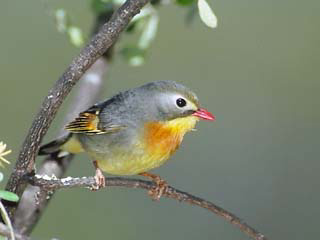Red-billed Leiothrix
|
Male, T. D. and T. J. Snetsinger. 1998. Has the Red-billed Leiothrix disappeared from Kaua'i? 'Elepaio 58: 39-43. Male, T.D., S.G. Fancy, and C.J. Ralph. 1998. Red-billed Leiothrix (Leiothrix lutea). In The Birds of North America, No. 359 (A. Poole and F. Gill, eds.). The Birds of North America, Inc., Philadelphia, PA. Ralph, C.J., S.G. Fancy, and T.D. Male. 1998. Demography of an introduced Red-billed Leiothrix population in Hawaii. Condor 100: 468-473.
|
Red-billed Leiothrix (Leiothrix lutea) © 1990 Peter LaTourrette |
